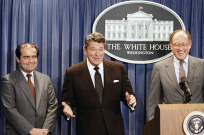How Journalists Portray the Court as a Partisan Institution
If the Supreme Court is viewed now as simply a partisan political institution, the journalists who cover it deserve some of the blame. The coverage of the Court is now almost universally refracted through the attitudinal model of political science, which essentially treats judges as politicians in robes who vote their political preferences, which in turn reflect the views of politicians who appoint them.
Coverage of the Brett Kavanaugh nomination is of a piece with this trend. The New York Times led with a story that tried to locate his ideological position on the Court through his $6,000 dollars of campaign contributions. (Never mind that some of these at least went to someone he worked with at a law firm and may reflect personal ties). And the focus in the press has been almost entirely on how he will vote in such cases as abortion and almost none on his methodological approach to interpretation. And this is a judge who recently wrote a long review essay on statutory interpretation in the Harvard Law Review.
Nor do journalists typically make a substantial examination of other justices’ methodology in reviewing the Supreme Court’s work. In particular, originalist arguments are now regularly made by justices and not only by those appointed by Republicans. In the academy originalism has become the theory to beat. But I cannot think of any major newspaper that devoted an entire article to the rise of originalism as a theory, even though it helps explain what would appear anomalies from the perspective of the attitudinal model, like Justice Antonin Scalia’s frequent votes for criminal defendants in closely contested cases. Even if one think that politics matters, methodology matters too, and the public would not gather that important feature of judicial decision making from much of the reporting on the Court’s work.
The best reporter today on Supreme Court, Adam Liptak, is a case in point. While he fairly reports on what the justices say in their opinions, his longer and retrospective essays on the Court are far more influenced by a view of the Court as a political institution than as a distinctively legal one. The scholar most frequently cited in his roundups appears to be Lee Epstein, a political scientist and champion of the attitudinal model who uses various measures to quantify a justice’s political ideology.
No doubt using such quantitative studies help protect Liptak (and other journalists) against the charges of political bias that were sometimes made against his predecessor, Linda Greenhouse. But this kind of analysis flattens reporting on the Court and in my view falsely makes the justices seem like largely partisan political players rather than actors engaged in serious jurisprudential debates.
Taking a relentlessly legal realist view of the Court is not a partisan bias, but it is a bias nonetheless. While reporters are welcome to view the Court through a political lens, they should also add a methodological one. The stereoscopic view of judging is richer and more accurate. It is also a better story.
Addendum: An earlier version of this post implied that imputation of bias to Linda Greenhouse may have been correct. I have revised the post to eliminate that implication.

